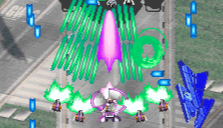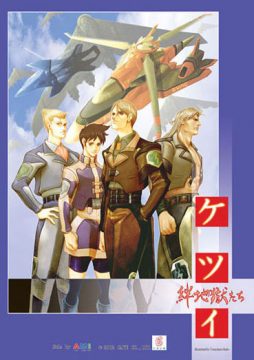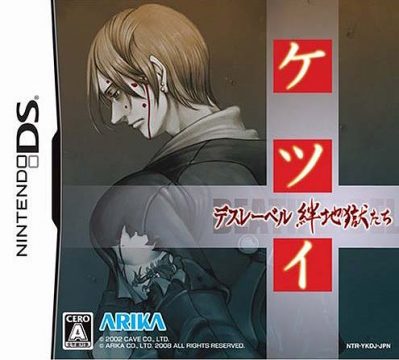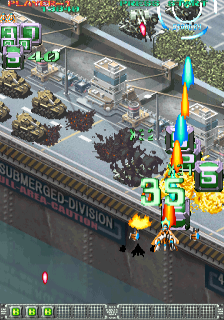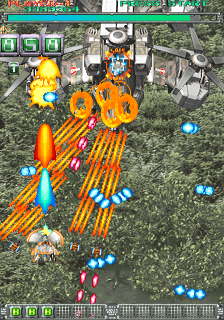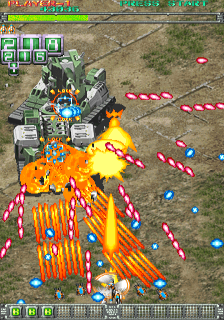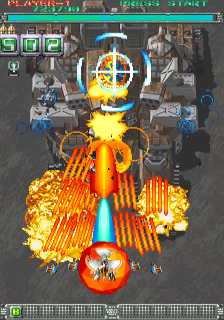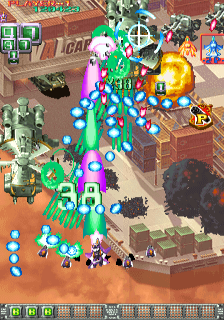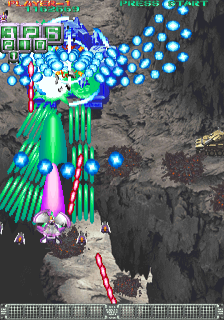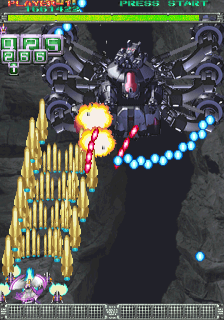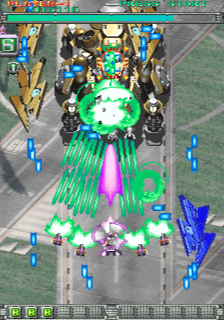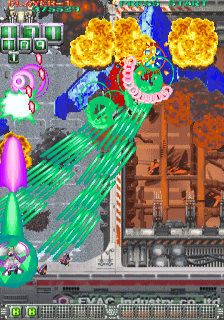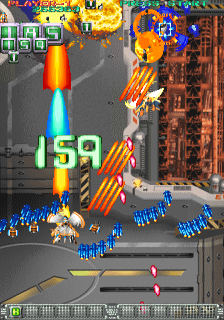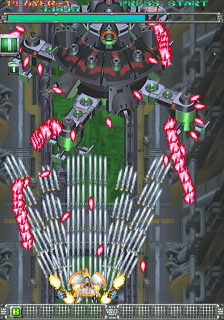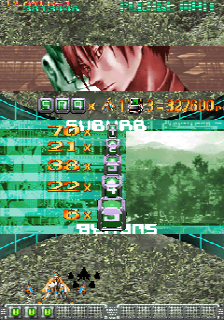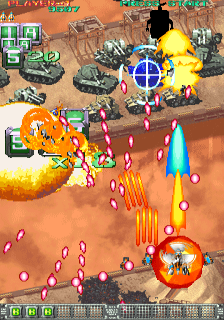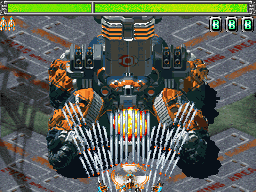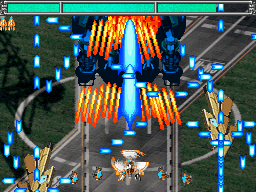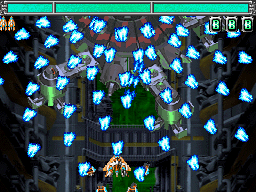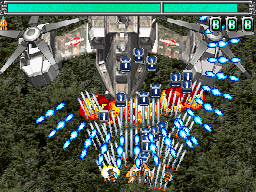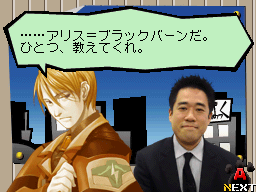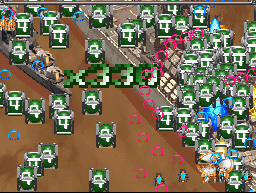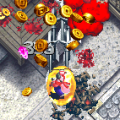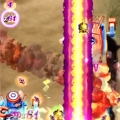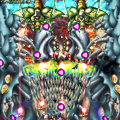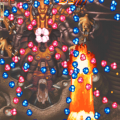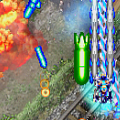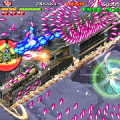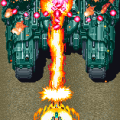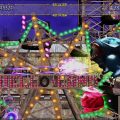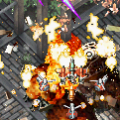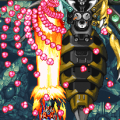Published in 2002, Ketsui: Kizuna Jigoku Tachi (“Determination: Cutting the Bonds of Hell”) is one of the many bullet hell shooters developed by Cave, lord and master of the subgenre. Despite its relative age, it’s become a favorite of shooter fans worldwide, routinely voted on polls as one of the companies’ best games. Part of the reason behind its legendary status may have had to do with the fact that the game didn’t get ported to a home console until 2010, leaving it unplayed except by those few with the resources and fortitude to survive the average smoke-filled Japanese arcade, but there are some substantially solid reasons behind its extravagant reputation.
On the surface, Ketsui is still a Cave shooter, much like any other. There are five stages, each with a boss and a mid-boss, and it is ridiculously difficult, with hundreds of bullets being sprayed across the screen at any given moment. There are two types of shots – a rapid fire shot which covers a wide spread, and a more focused, more powerful laser shot, which reaches about 4/5 the vertical length of the screen. There are also two ships, with some minor variations, mostly in their speed and bullet types. Full mastery of the initial five levels will open up two kinds of second loops. Beating the game without getting killed or using bombs, as well as scoring above 120 million points, will open up the Ura Loop, and will lead to an encounter with the true final boss, Evaccaneer Doom, of which very few players worldwide have, or will ever, reach on their own.
Aesthetically, Ketsui may as well be the neighbor of Dodonpachi, as it utilizes a similar post-apocalyptic military theme, as you fly over cities, armaments, and canyons. It’s dark, and more than a bit depressing, although the visuals skirt with inspiration with some of its more cleverly designed mid-bosses. The plot involves an assault by the United Nations on the evil EVAC Corp (“Cave” spelled backwards, if that weren’t apparent) in a mechanical, ravished world. The character art, what little there is, is supplied by Tomahoru Saito. Please note that this is one of the last times a Cave shooter starred a series of grizzled men and fighter jets, before moving onto slightly cutesier territory.
The music, like many of Cave’s games, is provided by Manabu Namiki, who has become the go-to person for retro arcade-style music. There’s a distinct motif that plays in several variations in the first, second and fifth stages, as well as the stage complete screen. The rest of the music is very spacey electronica, with some particularly harsh distorted guitars. The fourth level stage theme is excellent, if primarily because the rhythm seems to perfectly match the gyrating and spraying bullet patterns of the mid-boss.
Ketsui‘s primary differentiation, at least on the surface, is the vessel you pilot, some kind of amalgamation of a spaceship and a helicopter, rather than a traditional jet fighter. Additionally, when firing your primary laser, the secondary guns will automatically lock onto an enemy, dealing damage at an angle if you’re not firing directly at it.
This in itself is not a huge difference, but Ketsui‘s main appeal lies in its beautifully straightforward but remarkably complex scoring system. When an enemy is destroyed, it’ll drop a numerical chip with a value of 1 through 5. The value is determined by the proximity of your ship to the destroyed enemy – if you fire from across the entire screen, it’ll drop a 1, but get up close and personal, and you’ll be rewarded with a 5. There’s another catch though – any time you get a chip above a 1, a timer will count down, lasting for roughly second. During this period, any enemy destroyed with your laser shot will drop the value of the last chip you got, regardless of your position on the screen. Further destruction will add a few milliseconds to the timer, allowing you to keep the chain going. The key to scoring is to destroy an enemy up close to score a 5, then laser blasting as much as possible, before the timer runs out and you need to get another 5.
These chips are totaled up in the upper-left corner of the screen, which in turn will determine the multiplier when you defeat the level boss. There’s also a second multiplier, used to calculate the score when defeating enemies throughout the stage, which drains whenever you use your laser and forces you to balance its usage. When you encounter the boss, the top multiplier counts down, also forcing you to destroy it as quickly as possible.
The basics of this system are easily understandable, but taking advantage of them requires an intimate knowledge of how and when to use spread shot versus the laser, usually in milking a set of popcorn enemies to build up a chain to take on the big ones. While there’s still some level of memorization, it’s less rigid than the chaining system found in Dodonpachi games, where it was practically mandatory you knew the precise enemy layout on each and every level. It’s also less punishing when you die, because getting killed will drop the multiplier a bit, but won’t completely reset it. These elegant mechanics are part of what’s kept Ketsui so popular all of these years, especially among the hardcore shooter crowd, who continue to follow it despite the numerous Cave shooters that have come since.
Around 2003, Arika was set to port three of Cave’s shooters to the PlayStation 2 – Dodonpachi Daioujou (DDPDOJ), Espgaluda, and Ketsui. The first two made it to market, but Ketsui was cancelled due to technical issues. Why? Well, according to one of the lead programmers, there was an issue with the final stage. In the first half, you’re flying forward, but in the second half, you fly backwards over completely different scenery, as you’re supposed to be descending into an underground tunnel. Although not a particularly fancy effect by any stretch of the imagination, the PlayStation 2 apparently didn’t have enough RAM to pull this off without massive slowdown, so rather than compromise the port or make some alterations, they just cancelled the whole project altogether.
Skip ahead to 2008, and a small Japanese publisher named 5pb, known for gal games and other anime-style releases, had licensed two Cave titles for publication on the Xbox 360 – Dodonpachi Daioujou Black Label, an updated version of the game previously published on the PlayStation 2, and, again, Ketsui. Dodonpachi was the first to be released, which generated quite a bit controversy. The actual game played pretty well, despite some small issues that could cause issues for the truly hardcore players, but the shoddy menus and long loading times made the whole effort feel rather amateurish. Then another fact came to light – the company that 5pb had contracted the port out to had stolen Arika’s code from the PlayStation 2 release for use in the Xbox 360 version, something that’s on pretty sketchy legal ground and may have accounted for the bugginess. Needless to say, Ichiro Mihara, Arika’s vice president, became more involved in cleaning up the mess, and worked to ensure that Ketsui would not suffer the same fate. In the meantime, Cave released ports of three of their other games themselves – Deathsmiles, Mushihime-sama Futari, and Espgaluda II.
Finally, in April 2010, nearly two years after it had been announced, Ketsui was released for the Xbox 360 in Japan (and later on the PlayStation 3), under the full title Ketsui: Kizuna Jigoku Tachi Extra. It’s free from all of the problems that plagued Dodonpachi Daioujou Black Label port, and it’s remarkably solid all around. While the core game was ported quite accurately, the package as a whole seems a bit thin compared to Cave’s other ports. All of three of their other 360 games had upgraded graphics that, while not true HD, were still a step up from the low res arcade graphics. Ketsui is 100% faithful to the arcade version, visually, and so nothing was upgraded, although it has a variety of filters, including Nearest Neighbor (for those who loves pixels), Bilinear and Lanczos, although there’s no option for scanlines.
Similarly, Cave’s other games had several additional modes, including Novice modes, which drastically reduced the difficulty to newcomers could actually make some kind of progress. This would have been welcome, since Ketsui ramps up the difficulty around the end of stage 2 and doesn’t really let up. The only additional mode is the X Mode, which changes some of the base mechanics and scoring. Small enemies no longer drop chips, unless you’ve “activated” them by destroying a medium enemy, which begins the counter. This counter is much longer than the counter in the normal game, which changes the whens and wheres of your chaining. Destroying medium enemies will also cancel out their bullets.
The Xbox 360 port does contain an arranged soundtrack, which is decent enough, as well as online leaderboards, and the ability to upload your own replays, or download from high scorers around the globe. It almost making superplay DVDs redundant, although obviously the quality of the replays depends on who’s uploaded them. (Single credit playthroughs were, of course, available nearly on day one.) There’s a training mode to practice on individual levels, as well as a handful of options to disable slowdown, turn off bullets, or continue at Evaccaneer Doom. Some of these need to be unlocked through continued play. There’s also the usual achievements, as well as a tracker so you can view your progress. The PlayStation 3 port, released in 2013, is identical to the Xbox 360 release. However, while the PS3 version is region-free, the Xbox 360 version is not.
Even though it’s not nearly as full featured, Ketsui still stands tall among Cave’s later games. In some ways it’s a throwback to Cave’s previous era – it lacks the cutesy, otaku pandering visuals that started around Mushihime-sama and continued up until present, the atmosphere is much darker, and the scoring is much less arcane. If nothing else, it highlights the lasting appeal that Ketsui has, despite the ways that Cave has evolved.
While 5pb was messing around with the 360 port of Ketsui, Arika went back and adapted the game to the Nintendo DS. It’s not really a straight port, so much as a combination of a boss rush and a score attack. The main game consists of eight courses, each containing a number of bosses and mini-bosses, from the full arcade game, each fought in succession. The early courses only consist of three bosses, but the later ones require that you fight all ten in order to conquer. Occasionally in between boss fights are brief sections with standard popcorn enemies. Naturally in moving the focus onto boss battles, the scoring and chip gathering mechanics have changed a bit. You’ll consistently gain chips of varying values when you’re locked onto a boss, while in the arcade game, you only got them for destroying various sections or different forms. There’s no chaining either, completely negating the need to switch between spread and laser shots – you’ll always get score chips based on the proximity to the boss. It works pretty well, although some fans have expressed annoyance that you can milk extra chips from enemies by repeatedly tapping on the laser button instead of holding it, meaning that a fairly tedious action can be used to gain more points.
Auto bomb is also set on by default, which will drain your entire bomb inventory if you get hit, but saves you from losing a ship. Losing a course will also increase your default lives for that stage by one, up to twenty total. Your bombs are replenished after destroying a boss, and you’re even rewarded an extra one if you manage to defeat one without killed. In some of the later levels, you might very well need them. Death Label, one of the final courses, ends with a fight against Evaccaneer Doom, a relentlessly difficult fight. For the truly insane is Doom mode, which includes five successive fights against Doom, each with increasing difficulty.
Despite the move to a small, portable screen, and the change from a vertically oriented screen to a horizontally oriented one (the game does thankfully not use both screens, which would have been a nightmare), the game plays remarkably well. The action is just as smooth and rarely slows down, and it’s streets ahead of any other shooter on the Nintendo DS, of which there are few. Even the joypad, at least on a fat DS, controls better than one would expect. The squashed screen space does occasionally feel a bit cramped. The bullet patterns and speeds, for the most part, have been toned down a bit and adjusted, although as a whole the game is still very difficult. All of the music is streamed and taken straight from the arcade game, and all of the sound effects and voices are present too.
There are also a few two player modes. In Duel mode, you complete with the other player for chips. When one closes the gap by more than 200 chips, they have to hold that distance for three seconds. If the other fails to close the gap in that short amount of time, then they lose. In Kizuna mode, two players helm a single ship, but controls switch between them at set timed intervals.
While it’s a solid experience, it’s hard to shake off the feeling that Ketsui Death Label is merely part of a game rather than a whole, something that should’ve been an extra mode in a full release rather than a standalone product. It’s certainly no replacement for the full Ketsui, and seems more like a training exercise for bullet hell shooters, although not necessarily Ketsui itself, since the scoring systems are fairly different. But the bite-size playable chunks makes it ideal for portable play, and the various courses allow for plenty of replayability to improve score. There are plenty of unlockables as part of the “EVAC Report”. In addition to artwork galleries, there’s a feature called “Teach Me IKD-san”, where the in-game characters discuss strategies with Tsuneki Ikeda, developer at Cave, who appears as a digitized version of himself. Also included are a few high score videos, as well as a scaled down rendition of Stage 5 from the arcade game, only beaten by defeating all of the courses, and thus incredibly difficult to reach. (It’s really just easier to use an Action Replay code to unlock it, honestly.) Why they only included Stage 5 and not the others is a mystery, but the level that is present is just shamefully brutal.
Ketsui Death Label was also released with an Insanity DVD, showing a high score replay of the arcade game. The whole package had a low print run and the game disappeared off Japanese store shelves very quickly, resulting in aftermarket prices higher than what it initially retailed.
Links:
World of Arcades Detailed scoring mechanics and other little bits.
Cave STG An excellent, in-depth review about the levels and mechanics. (Archived in the Wayback Machine)
SHMUPS.com – Ketsui An early review of the game.
